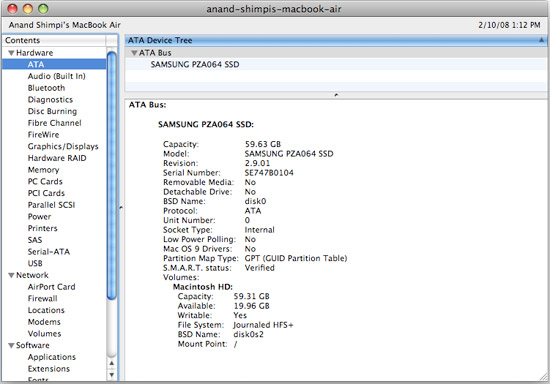The MacBook Air: Thoroughly Reviewed
by Anand Lal Shimpi on February 13, 2008 12:00 AM EST- Posted in
- Mac
The SSD Discussion
Apple inadvertently mitigated some of the dangers and annoyances of a mechanical hard disk in the Air by going with a 1.8" drive. These drives are used in the iPod and are designed to be rugged, cool and quiet. Because we're comparing an already low power, quiet drive to the SSD many of the advantages of the SSD just aren't as noticeable.
One aspect of SSD performance that isn't often talked about is that performance doesn't change as the drive gets fuller. Mechanical disk drives are designed to write to the outer most sectors first (where read speed is the fastest) and the inner most sectors last (where read speed is the slowest). When your drive is mostly empty, everything gets written to the fast part of the disk. As it gets full, data is written to the slower parts and thus you get degraded performance. The same doesn't apply to a SSD, since we're just writing to flash; performance is the same regardless of what part of the flash you're reading from.
If money were no object and we had to make a recommendation today, we'd still take the SSD over the mechanical drive. It is more responsive in the areas that bothered us the most when using the Air, it increases battery life by a good 14% on average and most importantly - it lowers the risk of a drive failure while on the road. The first stipulation of that recommendation is the one that's worth paying attention to: if money were no object.
Apple charges a hefty $999 for the 64GB SSD option, and on a $1799 notebook that's not insignificant; we're talking 55% of the price of a standard MacBook Air just for a drive swap. Apple isn't making that much profit on the drive either. The 64GB Samsung SSD Apple uses in the Air costs around $760, Apple actually makes more from the 200MHz CPU upgrade than the $999 SSD.
The beauty of solid state storage is that it's based on Flash, whose prices are directly influenced by Moore's Law. We've been told that within 3 months you can expect the cost of these 64GB SSDs to drop by around 30%, so we'd be looking at around $530 for the same drive in the near term. Obviously we're talking about cost here, if we apply the same 28% markup Apple currently uses on the SSD option to the new price we get around $680 for the SSD upgrade in 3 months. There's no guarantee that Apple will pass on the savings but if they don't, you can always shop around for the drive from another vendor such as DVNation.
Price isn't the only thing that will improve with time: performance will as well. When the transition to solid state disks first started happening the controllers (the chip that sits between the PATA/SATA interface and the Flash memory) were hardly optimized for performance. Because performance was so poor, the first SSDs were used for industrial applications where the ruggedness of the drives were most important and performance didn't really matter.
As controller technology advanced, so did performance but since the SSD market was still small the manufacturers had to pick and choose their battles. The natural fit for higher performance drives was the 2.5" SATA SSD market, after all these drives would be going into expensive notebooks. Controller development for PATA drives just wasn't as far along and thus PATA SSD offerings generally lagged behind in performance compared to their SATA counterparts.

The ZIF connector, it's bendy
In order to maintain the slim form factor of the Air, Apple stuck with a PATA interface for the hard drive; this isn't your grandmother's 44-pin PATA connector, it's a 40-pin low profile, ZIF (Zero Insertion Force) ribbon connector. There is no SATA equivalent so if you want to build a very small device you need to rely on a PATA drive, which is exactly what Apple did. Unfortunately, it also means that the $999 SSD Apple uses isn't the fastest SSD in the world - the 2.5" models are much quicker.
What about Smaller SSDs?
While the 64GB drive used in the Air is fairly expensive today, you can find cheaper 32GB drives on the market. The cost to manufacture the 32GB version is exactly 50% so the retail price ends up being about half as well. The problem is that 32GB isn't enough space for an often used OS X machine.
The default install of OS X and all of its applications that ship with the Air eats up close to 20GB of space; add a few necessities like Microsoft Office or Photoshop, not to mention copying DVDs/movies to your hard drive to watch them unless you want to lug around the external DVD drive as well and you'll quickly run out of space on a 32GB drive.

Ouch, only 19.96GB free? Hurry up Moore, we need larger SSDs.
When we were done installing all of the applications and test files needed for our benchmarks on the 64GB SSD we only had 19.96GB available. That's more than enough if you never install another application or copy any large content over, but chances are that won't happen.
Your best bet is honestly sticking with the 80GB PATA drive (unless money really isn't an object in which case just buy the SSD now and buy a larger one later) and upgrading to a 64GB or larger SSD when they are available.










41 Comments
View All Comments
Bunkerdorp - Tuesday, March 1, 2011 - link
See above the disk and the connector on the mainbord.My harddisk crashed and question is are there cables to connect this disk to a sata disk?
Perhaps I can recover the data but I can not find a cable or connector for this dis.
Perhaps you knpw a solution.
Thans very much.